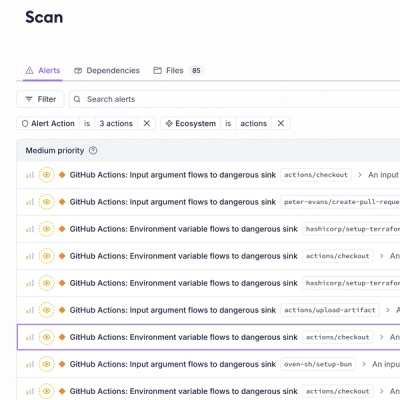
Product
Introducing Socket Firewall Enterprise: Flexible, Configurable Protection for Modern Package Ecosystems
Socket Firewall Enterprise is now available with flexible deployment, configurable policies, and expanded language support.
hops-lambda
Advanced tools
hops-lambdaPlease see the main Hops Readme for general information and a Getting Started Guide.
This is a preset for Hops that takes care of deploying your application to AWS Lambda.
Add this preset to your existing Hops project:
npm install --save hops-lambda
If you don't already have an existing Hops project read this section on how to set up your first Hops project.
When installed, this preset will add a new CLI command: $ hops lambda with the following sub-commands:
lambda deployExecuting this command will bundle all your dependencies and build artifacts into a single .zip file and deploy them to your Lambda function (or create a new Lambda function, if no previous stack was found).
lambda destroyThis command will destroy your CloudFormation stack and remove all resources that had been previously created.
--yesSpecify this argument to skip the interactive prompts.
--keep-filesYou can choose to keep the files that have been uploaded to your S3 bucket.
--keep-bucketChoose this, if you don't want to delete the S3 bucket but instead empty it.
In order to use this preset, you need to configure your AWS credentials.
To set-up your credentials in a ~/.aws/credentials file, please follow this article.
To set-up your credentials via environment variables, you can define the following variables:
AWS_ACCESS_KEY_IDAWS_SECRET_ACCESS_KEYAWS_SESSION_TOKEN (optional, only required for MFA)To quickly deploy a Hops application to AWS Lambda you need to have basePath and assetPath set to prod (or your configured stageName, if you have a differently named stage) and execute a build $ hops build -p.
Then execute:
$ hops build -p
$ hops lambda deploy
To update your application, simply do your code changes, build again and execute hops lambda deploy again and it will only update the parts that have changed since your last deployment.
The Lambda runtime supports a single Node version, that intersects Hops's supported version range: nodejs12.x. To explicitly set a Node version, use the "node"-property of the Hops config. If the property is not set, Hops will detect and use the Node version of the development environment.
Learn more about the available Lambda runtimes.
If you want your application to be available on a custom domain, you need to configure domainName and certificateArn. Optionally you can set a custom basePath and assetPath if you want your application to be available on a different path.
In order to use a custom domain name for your Hops application, you need to create or import an SSL certificate in the AWS Certificate Manager.
Check out the documentation of ACM, especially the sections about importing or requesting a certificate.
Important: Even if you deploy your application in a different region, you need to import or request the certificate in the region us-east-1 (see the section about CloudFront and ACM here).
Once you have imported or requested a certificate in ACM, you need to configure its ARN and your custom domain name in your preset config.
Then, after you execute hops lambda deploy you will get an output with a CloudFront distribution address, which you need to configure with your DNS provider as an A-record or CNAME. Read more about it here.
At the moment it is not possible to do a multi-stage deployment with a single CloudFormation stack.
If you want to do it however, you will have to create multiple stacks, for example by changing the package.jsons name field or the AWS configs uniqueName value and then execute hops lambda deploy again.
This preset can be configured through the "aws" key in your preset config.
"hops": {
"aws": {
"region": "eu-central-1"
}
}
| Name | Type | Default | Required | Description |
|---|---|---|---|---|
aws.region* | String | us-east-1 | no | The AWS Region in which the resources should be created |
aws.uniqueName | String | hops-lambda-$name | no | A unique name that is used to identify the AWS CloudFormation Stack and S3 bucket. |
aws.memorySize | Number | 128 | no | The memory allocated to your Lambda function |
aws.stageName | String | prod | no | The name of your API Gateway stage |
aws.domainName | String | '' | no | A custom domain name |
aws.certificateArn | String | '' | no | If a custom domain is used, this option needs to specify the ARN of a valid SSL certificate in ACM |
aws.cloudformationTemplateFile | String | node_modules/hops-lambda/cloudformation.yaml | no | Path to a custom CloudFormation template |
hops-lambda will try to read AWS_REGION and AWS_DEFAULT_REGION from your environment first before defaulting to us-east-1.regionThe AWS Region in which your resources will be created. You can configure this either through this config key or you can set one of the following environment variables: AWS_REGION, AWS_DEFAULT_REGION.
uniqueNameThis is a unique identifier that is being used to identify your CloudFormation stack. Changing this option only makes sense, if you want to do a multi-stage deployment.
memorySizeBy changing this value you can increase the memory size and the compute power that is available to your Lambda function. AWS allocates CPU power proportional to your memory size, so increasing this value will increase the performance of your application.
Read more about memory and CPU power and limits of Lambda functions
stageNameThe stage name is a concept of the AWS API Gateway and is usually used to separate API versions. Since you can not create an API Gateway without a stage this property defaults to prod.
When you use a custom domain, you won't have to worry about the stage name, but in the case of a simple deployment to the API Gateway, the stageName will become your basePath: https://{random-id}.execute-api.{region}.amazonaws.com/{stageName} and therefore you need to set your basePath and assetPath to include the stageName.
"hops": {
"basePath": "/my-stage",
"assetPath": "/my-stage/assets",
"aws": {
"stageName": "my-stage"
}
}
domainNameIf you want your application to be available on a custom domain you can configure that domain name with this option. Also note: When using a custom domain the certificateArn option must be configured.
"hops": {
"aws": {
"domainName": "my-domain.com",
"certificateArn": "arn:aws:acm:..."
}
}
certificateArnThe ARN of your SSL certificate that you have imported or generated through the AWS Certificate Manager.
"hops": {
"aws": {
"certificateArn": "arn:aws:acm:..."
}
}
cloudformationTemplateFileIn case you need additional resources in your CloudFormation template, you can overwrite the default CloudFormation template using this option.
In order to pass additional parameters to your CloudFormation stack you need to call the deployLambda(parameterOverrides) mixin method yourself. These parameters will get merged with the default parameters that Hops sends to the stack.
"hops": {
"aws": {
"cloudformationTemplateFile": "./path/to/my/template.yaml"
}
}
This preset has no runtime configuration options.
Caution: Please be aware that the mixin hooks are not part of the SemVer API contract. This means that hook methods and signatures can change even in minor releases. Therefore it's up to you to make sure that all hooks that you are using in your own mixins still adhere to the new implementation after an upgrade of a Hops packages.
deployLambda(parameterOverrides): Promise<Outputs> (override) coreCall this method from a mixin to programmatically execute a Lambda deployment.
You can overwrite or pass additional parameters to the CloudFormation stack by using parameterOverrides, which should be an object whose entries correspond to the names/values of the parameters.
destroyLambda(): Promise<void> (override) coreUse this mixin method to programmatically destroy the CloudFormation stack and all its associated resources.
FAQs
Quick and easy deployment of Hops applications to AWS Lambda
The npm package hops-lambda receives a total of 1,152 weekly downloads. As such, hops-lambda popularity was classified as popular.
We found that hops-lambda demonstrated a not healthy version release cadence and project activity because the last version was released a year ago. It has 8 open source maintainers collaborating on the project.
Did you know?

Socket for GitHub automatically highlights issues in each pull request and monitors the health of all your open source dependencies. Discover the contents of your packages and block harmful activity before you install or update your dependencies.

Product
Socket Firewall Enterprise is now available with flexible deployment, configurable policies, and expanded language support.

Security News
Open source dashboard CNAPulse tracks CVE Numbering Authorities’ publishing activity, highlighting trends and transparency across the CVE ecosystem.

Product
Detect malware, unsafe data flows, and license issues in GitHub Actions with Socket’s new workflow scanning support.